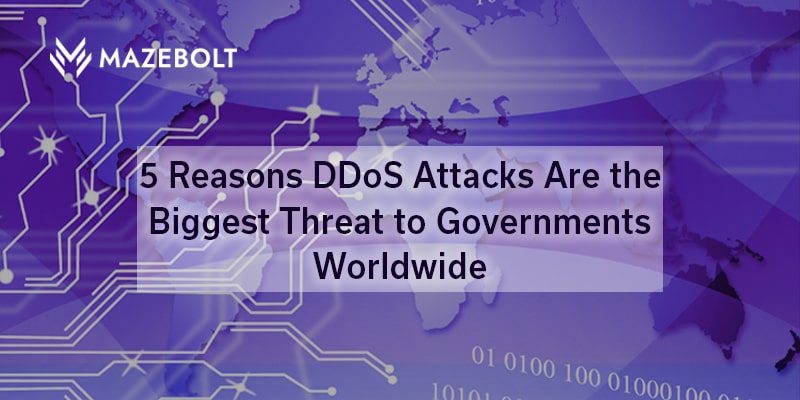DDoS attacks on governments have continued to make headlines in the last couple of years, elevating them to the top of many countries’ national security agendas. With the growth in digital and cloud technologies, the internet has become another major battlefield used for launching DDoS attacks that cripple services and paralyze communications across entire countries.
Why DDoS attackers are targeting Government institutions:
-
Political Upheavals
-
Ideological Belief
-
Cyber Warfare
-
Ulterior Motives
-
Extortion
-
Political Upheavals
DDoS attacks are among the most visible and disruptive of cyber-attacks to cause political disruptions. On July 16th this year, the Russian Defense Ministry’s website was knocked offline. The attack was claimed to be the work of a foreign cyberattack. Ukraine’s Defense Ministry portal has also been DDoS attacked several times. DDoS attacks can often be witnessed during elections. Politically motivated attacks are aimed to cause the victim damage or register their displeasure with some actions. Before and during the US elections, political campaigns experienced an average of 4,949 cyber-threats per day, and larger campaigns even more. Government election-related sites were seeing over 122,000 threats every day. This is problematic given that nowadays, campaigns rely heavily on online platforms like video conferencing, online fundraising, and social media to reach voters.
-
Ideological Belief
Hackers become motivated to attack political targets because of their ideological beliefs against nation-state or government policies. This motivation has become an influential reason behind many DDoS attacks. In January 2019, Zimbabwean government-related websites were hit with a DDoS attack by the hacktivist group Anonymous protesting internet censorship in the country. Philippines Rights Group Karapatan suffered heavy and sustained DDoS attacks proxied using at least 30,000 bots. -
Cyber Warfare
New Zealand was targeted on September 14th, and the DDoS attack crippled its essential services for days, including Inland Revenue, Met service, and various postal services. The attack on Ireland this year was a forerunner for a larger ransomware attack. There are also incidents of “state-sponsored” attacks. The 2020 Australia government attacks, targeted Australian businesses and governments. The attacks were described as “state-sponsored”, which means a foreign government was believed to be behind it. -
Ulterior Motives
Historical data indicates that for hackers, any large-scale event is an invitation to launch a DDoS attack. In March 2020, the US Department of Health and Human Services was hit by a DDoS attack just as the agency was scrambling to provide information and critical services in response to the COVID-19 coronavirus pandemic. While the attack was unsuccessful, the potential impact of a successful attack would have been enormous. With the HHS system down, it would have been easy for cyber attackers to spread disinformation, set up fake government websites, and potentially steal data from network systems left exposed. DDoS attacks on governments can stun day-to-day operations like the Sep 25th DDoS attack on the Netherlands Ministry of Health Corona Check system that prevented the creation of QR codes that the government has necessitated to gain entry to catering and cultural establishments. -
Extortion
Along with political motives, hackers indulge in attacks for cyber extortion demanding ransom in the form of Bitcoin. The hackers demand ransom, threatening data exposure or long periods of downtime if the ransom is not received. On May 14th, 2021, Ireland’s Health Service Executive (HSE) was down, and it was reported that the DDoS attacks were a forerunner for a larger ransomware attackhttps://info.mazebolt.com/ddos-attacks-on-government-2021?utm_campaign=General-MazeBolt-Promotion&utm_source=blogdomain-reasons-ddos-attackers-on-government-blog&utm_medium=promotions&utm_content=ddos-government-infographics
How governments can best mitigate DDoS attacks
Few steps any government organization can take to avoid getting hit by a DDoS attack:
- Install Web service applications on many independent servers based in different parts of the world. However, they could still be hacked, though all of them going down at the same time may not happen.
- Use the services of independent DDoS proxy service providers, but this could involve some latency and even some points of failure.
- Protect systems with the best IP filtering appliances available, but that would need weekly testing using tools designed for this for effective management.
- Use specialized DDoS mitigation services from leading vendors, but even with regular testing and the best mitigation systems installed, DDoS traffic still manages to bypass DDoS mitigation defenses and cause damage. The resulting DDoS vulnerability gap is a staggering 48%, causing system disruption and downtime.
The main challenges of DDoS mitigation solutions
DDoS attacks are increasingly more complex and quick. They leave much less time for current DDoS mitigation systems to react. Many DDoS attacks manage to penetrate the best mitigation solutions. To address these challenges, there is a need to detect and eliminate all DDoS vulnerabilities continually — before an attack is launched.
RADAR™ testing identifies all DDoS vulnerabilities in real-time, constantly analyzing the target network attack surface exactly as a hacker would. It does this by testing every attack vector against all web-facing IPs and targets in live production environments, so there isn’t any downtime. It then prioritizes the vulnerabilities by the number of targets found and gives extensive details about the nature of those vulnerabilities. This information enables proper mitigation and remediation setup. Once the remediation is completed RADAR™ testing validates the remediated vulnerabilities ensuring the remediation process was successful. It’s also DDoS-mitigation agnostic, so it works with your existing DDoS mitigation provider to respond in the fastest possible way with minimal manual intervention.
Why governments need continuous DDoS testing
DDoS vulnerabilities are never eliminated unless you are constantly testing for them. That’s particularly true today, as DDoS attacks are becoming more frequent and complex. That’s why governments need DDoS testing that is always on, constantly testing, and non-disruptive to live production environments.
Few benefits of continuous DDoS testing:
-
Ensure operational continuity
Governmental institutions provide critical services to their citizens and must be able to function regardless of political elections or political upheavals. DDoS attacks must be prevented to avoid downtime. Advanced DDoS testing, such as RADAR testing has this proactive approach and is also non-disruptive, so it continuously identifies DDoS vulnerabilities without any need for maintenance windows (i.e. downtime) for government websites.
-
Data-driven protection
Most DDoS testing doesn’t deliver DDoS vulnerability reports to demonstrate their ability to constantly eliminate them. With RADAR testing reports, you can see the number of simulations conducted and the percentage of vulnerabilities that are protected, vulnerable, and partially protected for each target. These reports are generated according to the number of connections per second sent by MazeBolt’s simulation cloud, with the corresponding number of connections per second that bypassed the current DDoS mitigation defenses.
-
Reduce the workload of in-house IT staff
As a result of the inherent weakness in existing mitigation solutions, the IT staff are pulled into action after a DDoS attack has occurred. This staff must stop their regular activities to instead focus on identifying and mitigating DDoS attacks. Since RADAR™ testing prevents attacks, attack mitigation is irrelevant. IT teams are spared from these sudden, stressful mitigation activities and can continue to focus on their day-to-day activities.
Interested in your government institutions benefitting from the most accurate DDoS testing in the market today?







